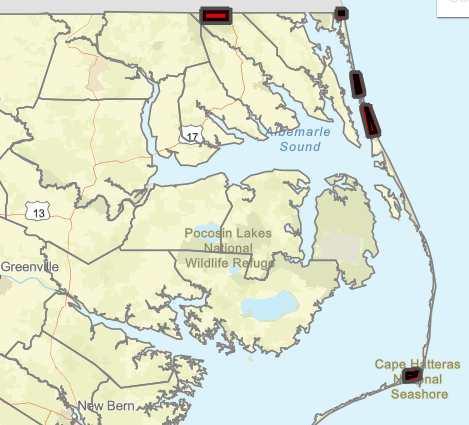
More gypsy moths has been found in more locations along the Outer Banks, with the state planning to treat the affected areas in late spring of 2022.
The invasive species feeds on the leaves of more than 300 species of trees and shrubs, predominantly oaks and hardwoods.
When areas become heavily infested, trees may be completely stripped of foliage, leaving yard trees and entire forests more susceptible to attacks from other pests. Severe infestations often lead to tree death.
Gypsy moth caterpillars can also pose public health concerns for people with respiratory problems. In areas with high-density gypsy moth populations, the caterpillar hairs and droppings may cause severe allergic reactions.
The N.C. Department of Agriculture and Consumer Services has addressed spot introductions of the gypsy moth across North Carolina since the 1970s. The treatment will be done in cooperation with the U.S. Department of Agriculture’s Forest Service and the Gypsy Moth Slow the Spread Foundation, Inc.
An area of Buxton Woods on Hatteras Island has been undergoing treatments for gypsy moths multiple times over the last decade.
Three additional areas on the Outer Banks, in Southern Shores and Duck, southern Corolla and Carova Beach, have now been identified by agriculture officials as needing treatment. Two other areas are on Knotts Island and northwest Camden County.
Public meetings will be held in the coming months on the proposed treatments. One has been scheduled for Tuesday, February 8, at 6:30 p.m. at the Duck Town Hall.
If you are unable to attend the in-person meeting, you can find out more information, submit a public comment, or to request email/text notifications about treatment dates by visiting www.ncagr.gov/GypsyMoths/treat.

North Carolina Department of Agriculture & Consumer Services description of the treatment areas:
Martin Point area: This 3168-acre proposed treatment block is the Duck area in Dare County. In 2020, we caught a total of two male moths in this block. In 2021, that number increased to twenty-seven. One application of mating disruption is proposed for this block in May or June.
Mossey Island area: This 1933-acre proposed treatment block is in Currituck County. This is a quarantine county for Lymantria dispar. In 2020, we caught zero male moths in this block. In 2021, that number increased to twenty-three. One application of mating disruption is proposed for this block in May or June.
Buxton area: This 1194-acre proposed treatment block is on the west side of Buxton in Dare County. NC 12 passes through the northern side of the block and Cape Hatteras National Seashore lies to its south. It is a mix of residential areas, commercial development, and one large maritime forest. There are small streams, canals, and swamps in the block and the Pamlico Sound borders the north side. Wooded areas are composed of oaks, pines, and various other hardwoods and conifers. Past treatments of mating disruption and Gypchek and Bacillus thuringiensis var. kurstaki at this site reduced the population significantly, but follow-up trapping indicates there is still a reproducing population present within this block. In 2020, we caught a total of thirty-nine male moths in this block. In 2021, that number decreased to twenty. One application of mating disruption is proposed for this block in May or June.
Lake Drummond area: This 5673-acre proposed treatment block is in Camden County and continues north into Virginia. On the North Carolina side, this block consists mostly of the Great Dismal Swamp National Wildlife Refuge and Dismal Swamp State Park. There are no residences in the block. In 2020, we caught a total of four male moths in this block. In 2021, that number increased to one hundred forty-seven, signifying that a reproducing population is present. One application of mating disruption is proposed for this block in late May or June.
Knotts Island area: This 311-acre proposed treatment block is in Currituck County and continues north into Virginia. This is a quarantine county for Lymantria dispar. In 2020, we caught a total of four hundred eighty-two male moths in this block. In 2021, that number increased to eight hundred fifty-two. One application of mating disruption is proposed for this block in May or June.
More information about gypsy moth biology and treatment options:
"along" - Google News
December 22, 2021 at 05:11PM
https://ift.tt/3Jb8dw8
Gypsy moth infestation spreads along Outer Banks; treatments set for 2022 - OBXToday.com
"along" - Google News
https://ift.tt/2z4LAdj
https://ift.tt/35rGyU8
Bagikan Berita Ini


















0 Response to "Gypsy moth infestation spreads along Outer Banks; treatments set for 2022 - OBXToday.com"
Post a Comment